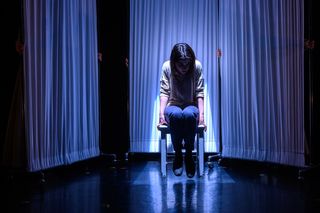Coronavirus Disease 2019
COVID-19 Welcomes the World to Brain Injury-Type Isolation
A virus shows the world what life is like for their injured friends and family.
Posted March 23, 2020 Reviewed by Gary Drevitch

Welcome to the world of isolation.
You are joining people with chronic illnesses like chronic fatigue and debilitating injuries like brain injury. You are finding out what it's like to be in my world, where people stay physically away from you, and you're alone in your home, with maybe a cat or dog to keep you company and not much else — except that because the whole world, literally, is in the same boat, people are reaching out to you and you have the energy and ability and means to reach back. But those of us with brain injury remain isolated within the self-isolation of SARS-CoV-2, the official name of the novel coronavirus.
Isolation is no fun when the world isn't in it with you. People are busy. People see their own life filled with people, cannot imagine being in a home with no one but themselves, and prefer not to think about it. Suddenly, a virus sneaks out of an animal, infects a human, who infects another and another and another until the virus replicates itself around the world, and all the healthy people must join the social isolation movement of the elderly with no family, the chronically ill with no energy, the ones with brain injury with so many physical and cognitive problems and sensory overload that one is forced to rest in isolation for weeks to recuperate from participating in bits and pieces of regular life.
Suddenly, a virus shows the healthy what life is like for their ill and injured family and friends.
Yet, the healthy still see it as about themselves.
Only a few get it, like the Anglican Reverend whose parishioner said to her in a matter-of-fact voice, "This has been my life for the past few months." The Reverend, in her self-isolation, hadn't cottoned on to that simple fact until her parishioner had baldly told her. Apparently, empathy doesn't come from being told, "this is my life," nor from shared experience, but from a combination of the two. Experience the stress, fear, and discombobulation of isolation, then hear from a person you know, "This has been my life for the past months, years," and the healthy, who never thought to visit nor include virtually this person, go, "Oh."
At first, I approached coronavirus self-isolation with humour, with the idea that since the world is joining me, maybe my weeks of recovery from doing too much won't be so bad. Instead of me waving futilely to get people's attention so that I can join in virtually, the rest of the world is scrambling to create virtual spaces that we with and without brain injury can all participate in. Except the people in my real life sniff at it. So much for that. Still, for the first time ever, since my brain injury threw me out of society, I'm back in because of the explosion of virtual spaces.
I can watch mini-music concerts on Twitter put on to cheer us all up; I can write this piece in response to this week's StayHomeWriMo; I can join others in disseminating good information on SARS-CoV-2 and COVID-19; I can virtually participate in church (something my church turned its nose up at when I suggested that it would help its downtrend and serve the disability community); I can work at my own pace without the pressures of the outside world demanding I do things their way or demand I endure early mornings, long rides on public transit to attend in-person appointments; I finally have the mental space to think about my life, what brain injury has done to it, what kind of community I'm in. And since this will be going on for about 18 months until they create and provide an effective vaccine and/or until effective treatment is found, I can work as slowly as my brain injury insists I do. I don't have to push myself to unendurable levels of fatigue. I'm still recovering from several months of pushing myself and inadequate rest. I enjoyed all the opportunities that exceeded the limits of my energy levels; but I feel so, so relieved that I can rest now. At last. Finally.
I have worries today, the same kind I had in the early years after my brain injury, and that the healthy in their self-isolation and physical distancing don't have.
How will I get groceries? In early brain-injury days, this worry came on because it was physically taxing and pain-inducing to buy groceries on my own. Today, my doctor has told me as a high-risk person, I must avoid stores and get delivery. The problem is that delivery is expensive: Small stores are offering free delivery and now have waiting lists while big-chain grocery stores have fees and charges and some have two-week waits on top.
Is it safe for me to go for a walk when so many in my neighbourhood won't comply with physical distancing? As governments enact emergency powers and crack down on people flouting Public Health rules, this might become safer for me to do.
How do I manage my brain-injury-affected sleep? My sleep routine is disrupted. Everyone's is. But those of us with brain injury suffer a significant downtick in our functionality because our sleep is already problematic. I'm working out a new sleep routine using audiovisual entrainment without help from any healthcare professionals as I wait for them to get their virtual care up and running.
I hope when this is all over, virtual participation in every aspect of society will be normal. Then we with brain injury can once again join the healthy in everyday life.
Copyright ©2020 Shireen Anne Jeejeebhoy. May not be reprinted or reposted without permission.


